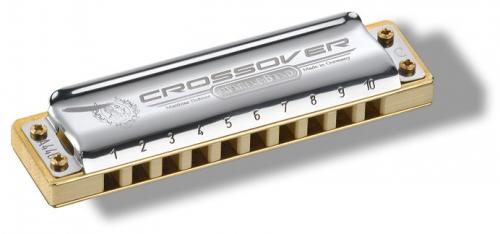I have had many people ask me to tune their harps "like a Crossover", something I am happy to do. Here are my thoughts on this tuning. First of all, regarding Hohner Crossover tuning, Steve Baker posted the following on Harp-L:
 0=443Hz w. minimal air pressure, all deviations are in cents, 1Hz = approx. 4 cents on most tuners
0=443Hz w. minimal air pressure, all deviations are in cents, 1Hz = approx. 4 cents on most tuners
Blow reed plate:
Root notes (1, 4, 7 & 10) tuned to 0
Thirds (2, 5 & 8) minus 5 cents
Fifths (3, 6 & 9) + 1 cent
Draw reed plate:
1-draw is very difficult to measure accurately. With absolutely minimal air pressure maybe +8 cents, more in low keys. Like that it will sound right with normal air pressure. It's essential that it sounds good when played together with 2-draw and as an octave interval with 4-draw.
2-draw + 4-6 cents depending on the key, at normal air pressure it should sound at the same pitch as 3-blow
3- & 7-draw tuned to 0
4- & 8-draw 1 cent higher than 2-draw (i.e. + 5-7 cents)
5- & 9-draw + 2 cents (this will mean the 7th chord sounds rough, but sounds better as a single note. You can even tune it a little higher if you prefer that sound)
6- & 10-draw 1 cent higher than 4-draw (i.e. + 6-8 cents)
It's highly recommended to check that all perfect intervals (octaves, fifths and fourths) sound without interference beats. This is what
piano tuners do too. You'll find it's damnably difficult to obtain constant readings from your tuner and I can only recommend playing very softly indeed and holding the note for a long time so you get a fairly clear note value. I use a Korg MT-1200 tuner with a built-in spread which tunes the upper octaves slightly sharper (as do piano tuners) and use the smallest spread the machine offers. It's hard to work to this degree of accuracy with a tuner which only shows Hz values.
Hope this will be of assistance,
Steve Baker
www.stevebaker.de
www.bluesculture.com
His description of how he tuned the master plates is very telling. It's not a bunch of theoretical numbers but a recipe to follow to replicate the sound of his own harps. The blow plate is A=443 with the thirds being somewhat less flat that the usual Hohner compromise tuning. It's much like the Manji compromise tuning - closer to ET but still a compromised tuning.
The draw plate is real-world tuned. I think because draw notes are usually more expressive than blow notes, many people hit them harder. The harder you hit a note, the flatter it will be. By tuning the root note to +6 (draw 2), the draw plate is really tuned to A=444 or higher. But as you play it "in the real world" such as on stage or while jamming, the draw 2 should sound the same as blow 3. The thirds on the draw side are tuned to zero, but relative to the root note (2 draw) they are -6, almost like the thirds on the blow plate (-5). The rest is again compromise, but close to ET. The sevenths are a little flat, as flat as the sevenths on a Seydel - again, relative to the draw 2.
I know Jason Ricci used to like his harps tuned to 443 on the draw side and 442 on the blow side.
I think the Crossover is the only out-of-the-box harp on the market today to compensate for the fact that the 2 draw and the 3 blow need to be tuned to different values to sound the same - for some of people, anyway. Consequently, the rest of the notes on the draw plate need to be a little sharp.
Some people hate the tuning. I reckon than some people don't hit the draw notes very hard (or hit the blow notes just as hard) and in that case, the draw notes are sharp or just plain out of tune.
This is the way I interpret this tuning. If anyone else has a different take, I'd be interested in it.